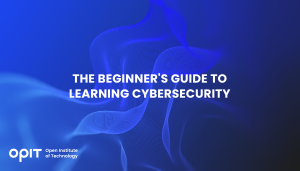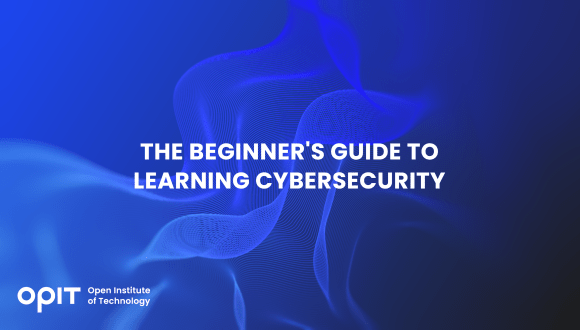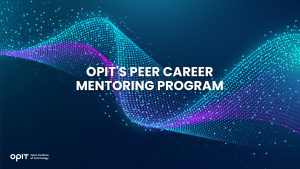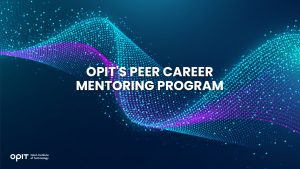

The world is shifting increasingly into an online world with every technological advancement. In this world, only one thing stands between your digital information and malicious actors – the presence of a cybersecurity team.
Cybersecurity professionals are in sky-high demand, and this trend isn’t slowing down. If you’re curious about joining their ranks and want to know how to learn cybersecurity, you’ve landed in the right spot. This roadmap will not only explain what cybersecurity is but how to get started in this exciting field.
Understanding the Cybersecurity Landscape
Cybersecurity might sound like a single, giant puzzle, but it’s more like a collection of smaller puzzles. It keeps the online space safe from threats and hackers, and the field spans various domains.
For example, network security keeps connections safe from attacks that lurk before you even access any website. On the other hand, application security fortifies the apps, while information security guards the data you share and store.
Another cybersecurity domain, ethical hacking, involves breaking into systems (legally, of course!) to find vulnerabilities before the bad actors do.
Learning about cybersecurity starts with getting familiar with the basics, such as concepts and key terms. Then, you have to keep up with the tech and threats, which means dipping into the latest trends in the cyber world.
Getting Started: Cybersecurity for Beginners
If you’re ready to address the question, “How to learn cybersecurity for beginners,” you’ll be glad to know that getting started isn’t complicated. The following steps will get you started in the right direction:
- Step 1: Basic Knowledge. Many resources are easily discoverable online for free. Look for tutorials, blogs, and free courses that introduce the core concepts of cybersecurity.
- Step 2: Formal Education. Once you’re comfortable with your basic know-how, it’s time to dive into structured learning. Paid, full-curriculum online courses and certifications for beginners are more comprehensive. Organizations like CompTIA and (ISC)² offer foundational certifications like Security+ and SSCP.
- Step 3: Practical Experience. Learning theory is a great way to build a solid foundation, but cybersecurity is a hands-on field. You’ll need practical experience, so take part in labs, simulations, and project-based learning like Hack The Box or CyberSecLabs to apply what you’ve learned in the real world.
OPIT’s Role in Cybersecurity Education
OPIT’s cybersecurity program give you a strong base in cybersecurity principles blended with the real-world side of the field with practical, hands-on applications. You will team up with experts who know the ins and outs of cyber threats, the latest tech defenses, and strategies that work.
There’s even more.
OPIT’s lectures and exams are nothing like the typical classroom-style courses you might’ve found at other educational institutions. In the program, you’ll have access to virtual labs and have you work on live projects. You’re being given the keys to a safe cyber playground where you can test skills, make mistakes, learn, and grow without the risk of letting the real intruder in.
Building Essential Cybersecurity Skills
Here are some of the core skills every beginner needs to develop to enter the complex and ever-evolving sphere of digital security.
- Encryption is how information stays safe from prying eyes online. As a beginner, learning encryption means learning how to use these secret codes to protect data and keep it readable only by the intended recipient.
- Network protocols are the web’s traffic rules. Getting to grips with these protocols will help you understand how data travels across the web and how to keep it secure as it does. You learn the pathways and the signposts – HTTP, HTTPS, FTP.
- Cybersecurity picks apart your mindset as much as it does the tools and technical skills. Sharpening analytical thinking is akin to becoming a digital detective. You’ll learn to look beyond the obvious and piece together clues to uncover potential threats before they strike.
- Every day in cybersecurity brings a new problem to solve, like finding a vulnerability in a network or responding to a cyber-attack. Your problem-solving ability to think on your feet and devise solutions will be your greatest asset.
However, while all these skills are invaluable and necessary, there’s one aspect that, if you’re lacking, might set you back from becoming top of the field. The cybersecurity field is as much about connections as it is about computers. By participating in webinars, attending conferences, and joining forums, you keep your knowledge up to date and build a network of peers and mentors. These interactions can inspire new ideas, offer support in tackling challenges, and open doors to opportunities in cybersecurity.
Why Choose a Career in Cybersecurity
Beyond asking how to learn about cybersecurity, you might also wonder why you should. It’s a career path full of excitement, challenges, and the immense satisfaction of making an impact on the world. Here’s why this field is worth considering:
In High Demand
Everything is going digital at an unprecedented rate. And with it, the need for skilled cybersecurity warriors. There’s a constant call for talent capable of safeguarding data and infrastructure against never-ending threats. Stepping into cybersecurity means you’re stepping into a realm where your skills are a shield for everyone’s very existence and functioning online.
Diverse Roles
Cybersecurity isn’t a one-size-fits-all career. It’s a mosaic of roles that cater to different interests and skills. For example, you might be intrigued by ethical hacking, fascinated by digital forensics, or drawn to creating secure networks. There’s always a niche for you. This diversity means you can find a path that plays to your strengths, keeps you engaged, and pushes you to learn more.
Making a Difference
Cybersecurity specialists are protectors. They shield not just bytes and data but people and their way of life. You have the power to prevent fraud, thwart cyberattacks, recover people’s precious data, and protect the privacy of individuals and the secrets of corporations. The impact is real, tangible, and incredibly rewarding.
Be the Cyber Warrior You’re Meant to Be
Cybersecurity starts with getting familiar with the basics and exploring accessible online treasures. You have to layer up knowledge with more structured learning as you dive into courses that challenge you more each time. Then, you get your hands dirty with actual work, where you learn the ropes by doing. The softer, more analytical skills will also be helpful, whether you’re taking time to figure out a complex problem or have to pivot for an immediate threat. And don’t forget to mingle in the cyber crowd—webinars, forums, the works.
Related posts

Source:
- Raconteur, published on November 06th, 2025
Many firms have conducted successful Artificial Intelligence (AI) pilot projects, but scaling them across departments and workflows remains a challenge. Inference costs, data silos, talent gaps and poor alignment with business strategy are just some of the issues that leave organisations trapped in pilot purgatory. This inability to scale successful experiments means AI’s potential for improving enterprise efficiency, decision-making and innovation isn’t fully realised. So what’s the solution?
Although it’s not a magic bullet, an AI operating model is really the foundation for scaling pilot projects up to enterprise-wide deployments. Essentially it’s a structured framework that defines how the organisation develops, deploys and governs AI. By bringing together infrastructure, data, people, and governance in a flexible and secure way, it ensures that AI delivers value at scale while remaining ethical and compliant.
“A successful AI proof-of-concept is like building a single race car that can go fast,” says Professor Yu Xiong, chair of business analytics at the UK-based Surrey Business School. “An efficient AI technology operations model, however, is the entire system – the processes, tools, and team structures – for continuously manufacturing, maintaining, and safely operating an entire fleet of cars.”
But while the importance of this framework is clear, how should enterprises establish and embed it?
“It begins with a clear strategy that defines objectives, desired outcomes, and measurable success criteria, such as model performance, bias detection, and regulatory compliance metrics,” says Professor Azadeh Haratiannezhadi, co-founder of generative AI company Taktify and professor of generative AI in cybersecurity at OPIT – the Open Institute of Technology.
Platforms, tools and MLOps pipelines that enable models to be deployed, monitored and scaled in a safe and efficient way are also essential in practical terms.
“Tools and infrastructure must also be selected with transparency, cost, and governance in mind,” says Efrain Ruh, continental chief technology officer for Europe at Digitate. “Crucially, organisations need to continuously monitor the evolving AI landscape and adapt their models to new capabilities and market offerings.”
An open approach
The most effective AI operating models are also founded on openness, interoperability and modularity. Open source platforms and tools provide greater control over data, deployment environments and costs, for example. These characteristics can help enterprises to avoid vendor lock-in, successfully align AI to business culture and values, and embed it safely into cross-department workflows.
“Modularity and platformisation…avoids building isolated ‘silos’ for each project,” explains professor Xiong. “Instead, it provides a shared, reusable ‘AI platform’ that integrates toolchains for data preparation, model training, deployment, monitoring, and retraining. This drastically improves efficiency and reduces the cost of redundant work.”
A strong data strategy is equally vital for ensuring high-quality performance and reducing bias. Ideally, the AI operating model should be cloud and LLM agnostic too.
“This allows organisations to coordinate and orchestrate AI agents from various sources, whether that’s internal or 3rd party,” says Babak Hodjat, global chief technology officer of AI at Cognizant. “The interoperability also means businesses can adopt an agile iterative process for AI projects that is guided by measuring efficiency, productivity, and quality gains, while guaranteeing trust and safety are built into all elements of design and implementation.”
A robust AI operating model should feature clear objectives for compliance, security and data privacy, as well as accountability structures. Richard Corbridge, chief information officer of Segro, advises organisations to: “Start small with well-scoped pilots that solve real pain points, then bake in repeatable patterns, data contracts, test harnesses, explainability checks and rollback plans, so learning can be scaled without multiplying risk. If you don’t codify how models are approved, deployed, monitored and retired, you won’t get past pilot purgatory.”
Of course, technology alone can’t drive successful AI adoption at scale: the right skills and culture are also essential for embedding AI across the enterprise.
“Multidisciplinary teams that combine technical expertise in AI, security, and governance with deep business knowledge create a foundation for sustainable adoption,” says Professor Haratiannezhadi. “Ongoing training ensures staff acquire advanced AI skills while understanding associated risks and responsibilities.”
Ultimately, an AI operating model is the playbook that enables an enterprise to use AI responsibly and effectively at scale. By drawing together governance, technological infrastructure, cultural change and open collaboration, it supports the shift from isolated experiments to the kind of sustainable AI capability that can drive competitive advantage.
In other words, it’s the foundation for turning ambition into reality, and finally escaping pilot purgatory for good.

The Open Institute of Technology (OPIT) is the perfect place for those looking to master the core skills and gain the fundamental knowledge they need to enter the exciting and dynamic environment of the tech industry. While OPIT’s various degrees and courses unlock the doors to numerous careers, students may not know exactly which line of work they wish to enter, or how, exactly, to take the next steps.
That’s why, as well as providing exceptional online education in fields like Responsible AI, Computer Science, and Digital Business, OPIT also offers an array of career-related services, like the Peer Career Mentoring Program. Designed to provide the expert advice and support students need, this program helps students and alumni gain inspiration and insight to map out their future careers.
Introducing the OPIT Peer Career Mentoring Program
As the name implies, OPIT’s Peer Career Mentoring Program is about connecting students and alumni with experienced peers to provide insights, guidance, and mentorship and support their next steps on both a personal and professional level.
It provides a highly supportive and empowering space in which current and former learners can receive career-related advice and guidance, harnessing the rich and varied experiences of the OPIT community to accelerate growth and development.
Meet the Mentors
Plenty of experienced, expert mentors have already signed up to play their part in the Peer Career Mentoring Program at OPIT. They include managers, analysts, researchers, and more, all ready and eager to share the benefits of their experience and their unique perspectives on the tech industry, careers in tech, and the educational experience at OPIT.
Examples include:
- Marco Lorenzi: Having graduated from the MSc in Applied Data Science and AI program at OPIT, Marco has since progressed to a role as a Prompt Engineer at RWS Group and is passionate about supporting younger learners as they take their first steps into the workforce or seek career evolution.
- Antonio Amendolagine: Antonio graduated from the OPIT MSc in Applied Data Science and AI and currently works as a Product Marketing and CRM Manager with MER MEC SpA, focusing on international B2B businesses. Like other mentors in the program, he enjoys helping students feel more confident about achieving their future aims.
- Asya Mantovani: Asya took the MSc in Responsible AI program at OPIT before taking the next steps in her career as a Software Engineer with Accenture, one of the largest IT companies in the world, and a trusted partner of the institute. With a firm belief in knowledge-sharing and mutual support, she’s eager to help students progress and succeed.
The Value of the Peer Mentoring Program
The OPIT Peer Career Mentoring Program is an invaluable source of support, inspiration, motivation, and guidance for the many students and graduates of OPIT who feel the need for a helping hand or guiding light to help them find the way or make the right decisions moving forward. It’s a program built around the sharing of wisdom, skills, and insights, designed to empower all who take part.
Every student is different. Some have very clear, fixed, and firm objectives in mind for their futures. Others may have a slightly more vague outline of where they want to go and what they want to do. Others live more in the moment, focusing purely on the here and now, but not thinking too far ahead. All of these different types of people may need guidance and support from time to time, and peer mentoring provides that.
This program is also just one of many ways in which OPIT bridges the gaps between learners around the world, creating a whole community of students and educators, linked together by their shared passions for technology and development. So, even though you may study remotely at OPIT, you never need to feel alone or isolated from your peers.
Additional Career Services Offered by OPIT
The Peer Career Mentoring Program is just one part of the larger array of career services that students enjoy at the Open Institute of Technology.
- Career Coaching and Support: Students can schedule one-to-one sessions with the institute’s experts to receive insightful feedback, flexibly customized to their exact needs and situation. They can request resume audits, hone their interview skills, and develop action plans for the future, all with the help of experienced, expert coaches.
- Resource Hub: Maybe you need help differentiating between various career paths, or seeing where your degree might take you. Or you need a bit of assistance in handling the challenges of the job-hunting process. Either way, the OPIT Resource Hub contains the in-depth guides you need to get ahead and gain practical skills to confidently move forward.
- Career Events: Regularly, OPIT hosts online career event sessions with industry experts and leaders as guest speakers about the topics that most interest today’s tech students and graduates. You can join workshops to sharpen your skills and become a better prospect in the job market, or just listen to the lessons and insights of the pros.
- Internship Opportunities: There are few better ways to begin your professional journey than an internship at a top-tier company. OPIT unlocks the doors to numerous internship roles with trusted institute partners, as well as additional professional and project opportunities where you can get hands-on work experience at a high level.
In addition to the above, OPIT also teams up with an array of leading organizations around the world, including some of the biggest names, including AWS, Accenture, and Hype. Through this network of trust, OPIT facilitates students’ steps into the world of work.
Start Your Study Journey Today
As well as the Peer Career Mentoring Program, OPIT provides numerous other exciting advantages for those who enroll, including progressive assessments, round-the-clock support, affordable rates, and a team of international professors from top universities with real-world experience in technology. In short, it’s the perfect place to push forward and get the knowledge you need to succeed.
So, if you’re eager to become a tech leader of tomorrow, learn more about OPIT today.
Have questions?
Visit our FAQ page or get in touch with us!
Write us at +39 335 576 0263
Get in touch at hello@opit.com
Talk to one of our Study Advisors
We are international
We can speak in:


